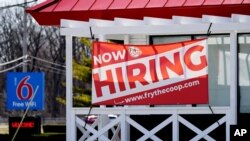New U.S. unemployment compensation claims dropped sharply last week to their lowest level in a year, the Labor Department reported Thursday, as the world’s biggest economy appears poised to fight off the damage caused by the coronavirus pandemic.
The government said 684,000 workers filed for benefits last week, down 97,000 from the revised figure of the previous week. It was the smallest weekly total of new jobless benefit claims in the United States since the coronavirus first swept into the country a year ago.
Since then, the number of jobless benefit claims has remained above 700,000 a week, and above 800,000 and 900,000 in some weeks in early 2021. Until the newest report, all the weekly totals for claims over the past year have been above 695,000, the highest pre-pandemic level in records dating back to the 1960s, after reaching a peak of 6.9 million claims a year ago.
Even with the improved jobs picture, it remains worse than before the pandemic. In 2019, unemployment compensation claims averaged 218,000 a week.
Employers in many states are still facing directives to curtail their operations, while some state governors are revoking orders for people to wear face masks and allowing businesses to fully reopen or setting dates in the coming weeks when they say businesses can ramp up.
The employment picture in the U.S. also could improve as money from President Joe Biden’s $1.9 trillion coronavirus relief package filters through the economy — legislation that Democrats in Congress pushed through over uniform Republican opposition. The measure could help boost hiring and consumer spending, as millions of Americans, all but the highest wage earners, started receiving $1,400 stimulus checks from the government in recent days.
Treasury Secretary Janet Yellen told Congress this week, “With the passage of the rescue plan, I am confident that people will reach the other side of this pandemic with the foundations of their lives intact. And I believe they will be met there by a growing economy. In fact, I think we may see a return to full employment next year.”
More than 2 million Americans are now being vaccinated against the virus each day, with Biden promising that any adult who wants a vaccination will be able to get one by the end of May.
More than 46 million Americans are fully inoculated with one of the three available vaccines, about 14% of the U.S. population. As that number grows, more people are regaining a sense of normalcy in their lives.
Even so, for the moment at least, employers in many states are still confronted with orders from state and municipal officials to restrict business hours or limit the number of customers they can serve at any one time to try to prevent the spread of COVID-19, the illness caused by the coronavirus. Those arriving for dinner in a restaurant, sometimes for the first time in a year, still find many establishments cordoning off every other table to keep customers safely distanced from each other.
U.S. employers added 379,000 jobs in February and the unemployment rate edged down to 6.2%. The country’s central bank, the Federal Reserve, predicts it could drop further to 4.5% later this year.
The Fed is expecting the economy to grow by 6.5% this year compared to its previous projection of 4.2%, with the growth rate slowing to 3.9% in 2022 and 3.5% in 2023.
Despite the rosier picture, Fed chair Jerome Powell cautioned last week that the economy will not instantly return to pre-pandemic levels.
“It’s just a lot of people who need to get back to work, and it’s not going to happen overnight,” Powell said. “The faster, the better.”
Under the $1.9 trillion relief deal, the federal government will continue making $300-a-week extra payments to the jobless into early September, on top of less generous state benefits, a provision that will help millions of unemployed until their old jobs are restored, or they find new work.
In the U.S., only slightly more than half of the 22 million jobs lost in the pandemic have been recovered.
U.S. employers have called back millions of workers who were laid off during business shutdowns in 2020. But some hard-hit businesses have been slow to ramp up operations again or have closed permanently, leaving workers idled or searching for new employment.
The coronavirus relief measure, however, almost certainly will give a new boost to the economy, easing the path for many employers to keep workers on their payrolls as coronavirus restrictions are gradually eased.
The U.S. has now recorded 545,000 coronavirus deaths and 30 million infections, both figures higher than that being reported in any other country, according to Johns Hopkins University.








